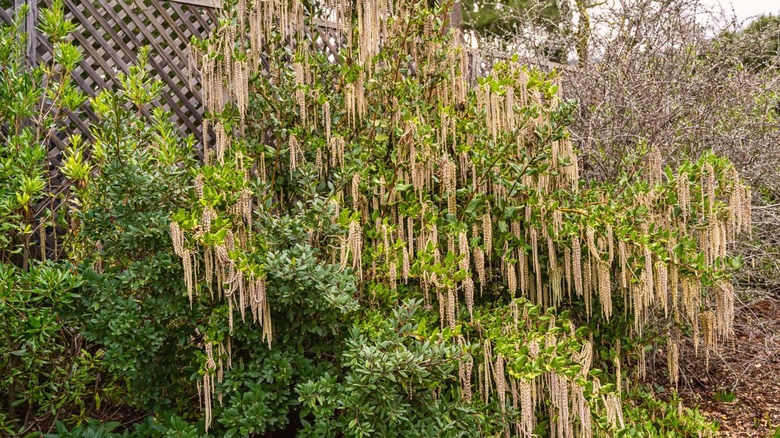Hide Your Fence Line In Style With These Low-Maintenance Evergreen Shrubs
Even the most architecturally interesting, modern front yard fences can appear to be unnatural additions, divorced from the surrounding greenery and natural landscape. Adding a row of plants reunites the fence with the yard. The dense shrubbery of the Pacific wax myrtle (Myrica californica) and the showy, dangling catkins of silk tassel bush (Garrya elliptica) are attractive, low-maintenance choices for hiding a fence while adding beneficial elements to the landscape. Both will animate your backyard by attracting songbirds, yet neither will attract deer.
The Pacific wax myrtle, also known as California bayberry or the Pacific bayberry, grows to a height of 30 feet. Four-inch-long fragrant, glossy leaves form dense foliage that can be left to grow naturally or trimmed into a hedge. This evergreen native of the Pacific coast has small flowers that bloom in the spring and clusters of drupes, small fruits with a stone in the center, that form in the late fall.
Silk tassel bush, also known as coast or wavyleaf silktassel, is a native plant that grows up to 8 feet tall as a shrub or 20 feet as a tree. Male bushes produce 12-inch-long catkins, narrow spikes of flowers, that droop from the branches and stay on the bush through summer. Female plants produce shorter catkins about 2 to 3 inches long that bloom in the late winter. If the female plants are fertilized, the bush creates clusters of fruit.
Growing conditions for Pacific wax myrtle and silk tassel bush
Pacific wax myrtle, hardy in USDA zones 7 through 9, isn't terribly picky about its growing conditions. Bushes thrive in well-drained clay, sandy, or loamy soil with a neutral or acid pH (here's how to measure your soil's pH). In coastal areas, wax myrtle does best in full sun. Inland, afternoon shade benefits the plant, but bushes with too little sun are usually less lush. While Pacific wax myrtle can tolerate dry conditions and is a drought-resistant plant, it can grow 2 to 4 feet a year with regular watering, producing dense branches all the way to the ground — making it a good choice for hiding a fence. Insect pests and diseases are typically not a problem, but there is a slight potential for damage from some insects like spider mites and diseases like leaf spot. The berries on the bushes attract a wide variety of birds, including robins and finches.
Silk tassel bush, hardy in zones 8 through 11, tolerates similar conditions to Pacific wax myrtle. It grows in a variety of soil types, as long as it's well-drained. The bushes tolerate occasional drought or periods of rain, but they may die in areas with excessive rainfall. On the coast, grow silk tassel bush in full sun; inland the plants prefer partial sun. Like wax myrtle, silk tassel bush attracts songbirds and is resistant to most insect pests and diseases, though leaf spot may be a problem. The outstanding difference between the two bushes is the dangling, green-yellow flowers growing to as long as 12 inches that appear on silk tassel bushes in the summer.

